
Hello everyone.
Today I would like to present to you a project which, as it were, arose from the urgent need to defend against a neighbor, or rather against his onerous smoke from his chimney.
Apart from the fact that my neighbor did not want to talk to me in any diplomatic way, he only poisons me and my family with this throat-biting smoke.
The smoke even enters my house through the ventilation and I have to close all vents and there is no measure of moisture due to this. It is impossible to live. I will be working on ventilation in the spring. I will walk her from the other side of the building.
By the way, not to be boring on the forum and not to write off topic - I am asking people who had or have such a problem to contact PW on how to deal with such a person - I will be grateful for any advice.
Returning to the project, after adjusting all the windows and doors, it turned out that the door is a bit leaky and there is an exchange of air due to the temperature difference and unfortunately, but mainly through the door, the stench enters my house. It was so bad luck that the smoke flies and crashes right on my door. And not far from the door I have a room where I, my wife and my 1.5-year-old son sleep. As the smoke enters the corridor, the moment is in the room where we sleep. I had a situation that I woke up in the night and neither here, man, you will not open the windows, you will not ventilate anything - you are choking in your own house. Until the morning, the four of us, sleeping on one bed, survived in the other room with my daughter, where it did not smell yet.
I have a porch made of plexiglass, but it does not give much smoke, it breaks against the porch and is stored in this porch - unheated porch - I will add and whether the door was open or closed the effect was the same.
So I created a porch overpressure ventilation project - only then the stench didn't come in through the door into the house. For the ventilation to work properly, the door in the porch must be closed, which means that due to the operation of the air supply in the porch there is a greater air pressure than outside, thanks to which air with smoke does not enter inside.
To create such an installation, I used an old computer fan with dimensions of 12cm x 12cm and a power of about 20W (current 1.6A - not those fans from the power supply, these are barely spinning - this one was for cooling the processor, as I am not mistaken in Dell's computer) and a few spiro tubes and a smoke detector which I quickly put together from Chinese modules. I have some concerns about the operation of such a sensor outdoors, but maybe it is difficult to manage and I will survive the winter.
A few photos of what I used below.
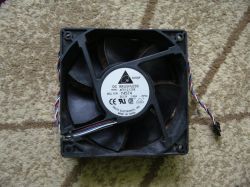



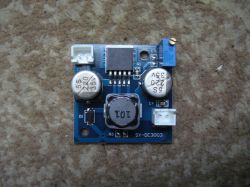
The entire installation is powered by 12V - at the beginning there was only a fan and a power supply, but 20W which the fan was taking continuously around the clock, it was a bit of a waste of electricity, especially since I bought an electric air dryer that runs 24 hours a day because the ventilation holes are clogged with moisture everywhere - besides, at night you can hear a little how the fan works, so the smoke detector has become indispensable, and since the whole is powered from the contact in the attic (because the spiro pipe goes there and there is a 230V socket), this sensor and the fan must be turned on remotely.
So the whole system is powered by 12V from the power supply. Unfortunately, it consists of Chinese modules - an electronic timer with a trigger input, remote control, MQ2 smoke detector, the aforementioned fan and a smoke detector matching system and an electronic timer which I made myself. I would probably do another one, but there was not much time to create because it was necessary to act immediately.
This is what a complex sensor looks like.


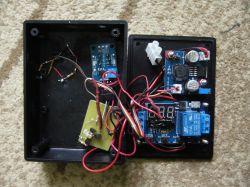
And this is what the mounted device looks like - I planned to put the device on the whole outside, but in case of flooding - it would be a pity, so it would be a pity, so only the plate with the MQ2 sensor went outside, I installed it in a plastic tube, on both sides I put grills like in radios from speakers - for so that the air passes freely through the pipe and thus, if smoke appears, the detector will detect and signal the device in the porch. In the event of flooding the sensor, it is possible to quickly replace it with a new Chinese module with the MQ2 sensor.
There is my matching circuit between the sensor and the rest of the device. The sensor has a potentiometer to set the sensitivity, in addition, the sensor board has an LM393 integrated circuit which acts as a comparator and compares the voltage from the sensor with the set voltage using the potentiometer. If the smoke level exceeds the set level, the detector's digital output is low. I can not give such a state to the input that triggers the timer because it just responds to the high state.
So my matching circuit consists of an inverter based on transistors T1 and T2, so after the signal passes through such an inverter we have a situation that when smoke is detected at the T2 output, a high state appears and theoretically it could be fed to the timer trigger input and it will work, but there is a problem. I set the timer for 2 minutes because I did not want him to walk for a long time when there is smoke in the sensor for a moment. But very often smoke appears for 30 minutes or even 2 hours and then there would be a situation that the sensor would give a low state - after passing through the inverter, this state is already high - the timer with the rising edge is started and counts down the two minutes set by me after which despite the fact that the status on the trigger input is still high, i.e. the smoke is still there, the timer turns off and it's over. In order to avoid such a situation, I thought to add one more transistor and LED diode to my inverter and make a simple generator - I will add that it is not an ordinary LED but a flashing one. Thanks to this, I have a state on the output for the entire duration of the smoke that changes every second (it depends on the diode which is flashing and thus when it is lit, it turns on the T3 transistor, and if it is off, it does not turn it on. The variable state at the output of my matching circuit This causes that the electronic timer is reset to zero every 1 second and starts counting from the beginning, thus, as long as the sensor detects smoke, the timer is turned on and reset all the time after the smoke disappears, the system counts the set 2 minutes and turns off.
Scheme and PCB of this matching circuit - I designed the PCB later, the version in the sensor is a bit different and finally it should be slightly modified as shown in the diagram and model below.
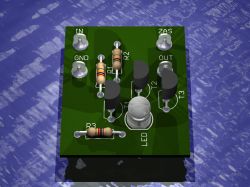

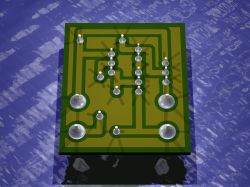

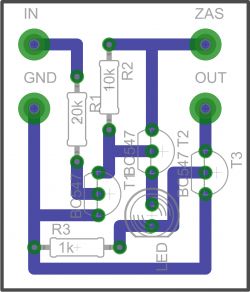
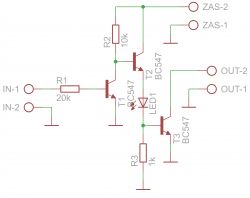
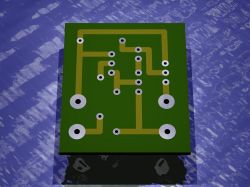

Noteworthy is also the fact that I used a step-down converter on the LM2596 chip, which reduces the supply voltage from 12V to 5V which is necessary to power the module with the MQ2 smoke detector.
The whole is connected by a two-channel radio remote control, so that you can control the device in front of the house and in the attic from your home. One remote control channel activates the smoke detector with a timer, which allows you to remotely turn off the device when you do not need it, e.g. in summer or when the winds are favorable, or when, for example, the sensor breaks down and the fan is turned on constantly when you do not want it. The second remote control channel turns on the fan regardless of the sensor status, the second channel remote control relay is connected in parallel with the timer relay, so you can turn on the fan independently when you need it and the sensor has not responded, e.g. due to a failure. You can also turn off the smoke detector through the first duct and turn on the fan manually through the second duct.
Block diagrams of connecting individual modules to each other, the first one shows my smoke detector for the modules used, and the second one shows the connection of the smoke detector to the installation.


Now a bit about the installation of the porch is fairly tight to which I led the pipe with "fresh" air - this pipe goes through the attic and comes out from the other side of the house where the air is cleaner and the air is sucked in by a fan which is located in the attic between the pipes and forced in it is to the porch, the porch is not completely airtight (it has gaps), even at the wall, tiles at the stairs or at the sliding door - when it is closed, when you put your hand to the gaps, you can feel the air coming out - thanks to this, smoke does not enter the porch and so not to feel at home.
A few more photos of the entire installation
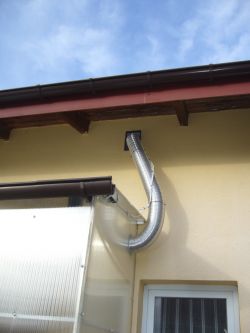
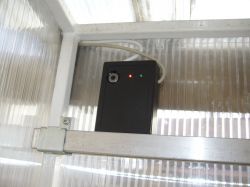


You could say the battle is won, but that doesn't solve the problem. I also have heating for eco-pea coal, but another neighbor to whom my smoke flies did not tell me anything, and yet I put a power regulator on the blower and reduced the blast so that it would not be so bad in the first minutes when switching on - of course then you have to extend the blower operation time in the controller settings from the stove. I tried to talk to my neighbor about it, but he didn't find time for me.
I'm just waiting for them to prohibit firing with rubbish and furnaces such as dust coal and others - I would like to change the furnace myself because I already have my old one (10 years old) and I would like to install district heating but it ended 300 meters away from me and I do not want to continue and other heating systems, such as gas, are expensive and I honestly cannot afford such expenses.
But I wrote about it - I am publishing a project of this positive pressure ventilation, maybe it will be useful to someone in the same or similar situation.
In case you had any questions, I'll be glad to help. I am waiting for comments, this is my twentieth published project - please be understanding, I read the regulations and I think that I did everything in accordance with them.
Cool? Ranking DIY




